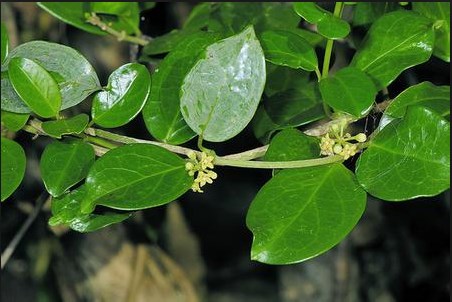Gymnema sylvestre

Common Names: Gymnema, Gymnema sylvestre, Australian cowplant, miracle plant, sugar destroyer, gurmar, Madhunashini, Meshasringi, Merasingi, Kavali, Vakundi, gymnema leaf, shardunika, Gymnema montanum, Merasingi, Periploca sylvestris, Gurmarbooti, Dhuleti, Podapatri, Adigam, Cherukurinja, Sannagerasehambu, Chinese cowplant, Hindi: gur-mar, Marathi: kavali, Sanskrit: madhunashini, Tamil: cherukurinja, Telugu: podapatri, Latin: Gymnema sylvestre
Latin Name: Gymnema sylvestris
Origin: Africa, Asia
Short Introduction
Gymnema sylvestre thrives best in warm tropical and subtropical regions that are not susceptible to cold or frost. It prefers well-drained soil, rich in humus and organic matter. The plant is best started with fresh compost at the beginning of spring or summer and does not do well in pots. For optimal growth, plant Gymnema in shaded areas close to larger, sturdier trees, which its vines can climb and flourish on. The plant requires regular watering (about three times a week), sufficient but not excessive. While Gymnema tolerates moist environments, it thrives best in mildly moist conditions.
Detailed Description
A remarkable herb with unique properties against diabetes and obesity.
Botanical Information
Gymnema sylvestre is a long, climbing vine with opposite, typically elliptical or oval leaves measuring 4–6 cm long and wide. Its small, regular, yellow flowers grow in cymose inflorescences about 6–10 cm long, resembling clusters or small grapes. The calyx is five-lobed, while the corolla is bell-shaped, cylindrical, and lanceolate. Its fruit takes the form of an ovate or elongated, hooked follicle, or sometimes an aggregate of several follicles.
Origin and Distribution
The Gymnema genus is widely distributed throughout tropical and subtropical regions of Asia, Africa, and Oceania. Gymnema sylvestre is most abundant in tropical and southern Africa, Madagascar, and across South Asia through Indonesia to Japan, growing wild in the tropical areas of southern and central India.
Usage / Dosage
Western medicine borrows from traditional folk medicine by using Gymnema extracts worldwide to support antidiabetic treatment and for glycemic control in both Type 1 and Type 2 diabetics. It's no surprise that Ayurvedic medicine has used Gymnema sylvestre for centuries to manage diabetes symptoms. As diabetes is a widespread modern disease, modern treatment regimens often include dietary management and gentle herbal support, including Gymnema. Some authors (2012, 2016) also highlight Gymnema’s potential for diabetes prevention in at-risk populations.
The active compounds of Gymnema have demonstrated the ability to stimulate insulin production and regulate blood sugar levels. The plant’s saponins—especially gymnemic acid—block taste receptors, numbing the tongue for several hours and thus reducing cravings for sweets. Application on the tongue or oral consumption decreases the desire for sugary foods, which is why Gymnema is sometimes called the "sugar destroyer." Gymnemic acid binds to the "sweet" taste receptors and decreases their activity, acting as an inhibitor of sweet taste. Gymnema’s compounds also reduce the absorption of sugars from the digestive tract as well as fatty acid absorption, thus impacting fat storage in the body. Gymnemic acid and its derivative, gurmarin, are largely responsible for the plant’s pharmacological effects.
Preclinical and clinical studies show that Gymnema sylvestre lowers blood sugar, increases the number of beta cells and pancreatic islets, and helps reduce high blood sugar. In patients with Type 1 diabetes, Gymnema reduces the need for insulin; in Type 2 diabetes, it may allow lower medication doses or even a reduction in the number of medications needed for glycemic stabilization. Its compounds exhibit a strong insulin-stimulating and hypoglycemic effect. Always consult a physician before using Gymnema for blood sugar control, since its effect is linked to reducing the reabsorption of sugars and cholesterol in the small intestine.
As a complex of peptide saponins, gymnemic acid can blunt sweet taste, and in vitro studies show it stimulates lymphocyte proliferation, enhances immune antibodies, and induces lymphocyte production in specific tissues. The gurmarin content also influences taste regulation similarly. Some studies have discussed Gymnema’s potential in metabolic syndrome therapy. Its compounds act as cardiovascular stimulants, and as regulators of liver and kidney metabolic functions.
Obesity is often a disorder of metabolism and triglyceride storage in fat tissue, potentially leading to insulin resistance. Reducing serum cholesterol and obesity can significantly decrease cardiovascular disease risk. Gymnemic acid has shown anti-obesity effects. Animal studies found that combining a cholesterol- and fat-free diet with Gymnema extract for 7 days significantly reduced serum total cholesterol, triglycerides, and LDL cholesterol, while increasing HDL cholesterol compared to control groups. At 200 mg/kg, Gymnema extract performed better than diet alone, showing notable anti-obesity efficacy. Regular intake for 45 days was associated with significant reductions in body weight and these serum parameters.
Traditional and Folk Uses
In traditional Indian medicine (Ayurveda), Gymnema leaves are used to stabilize blood glucose. For over 2,000 years, Gymnema sylvestre has been included in Ayurvedic therapies for hyperglycemia and weight management. It’s also given for eye problems, asthma, inflammatory conditions, snake bites, and for hepatoprotective, hypoglycemic, and antihypercholesterolemic effects. In Southeast Asian folk medicine, beyond glycemic control, Gymnema is used for migraines, enlarged lymph nodes, skin diseases, and coughs. Traditional Chinese medicine has used it for conditions such as tuberculosis, poliomyelitis, and other infections.
Active Compounds
The most important constituents of Gymnema sylvestre are glycosides, alkaloids, triterpene saponins (oleanans such as gymnemic acid I–VII, gymnemosides A–F, gymnemasaponins, and dammaranes), flavones, anthraquinones, hentriacontanes, pentatriacontanes, alpha- and beta-chlorophylls, phytic acid, resins, quercitol, tartaric acid, butyric acid, lupeol, stigmasterol, peptides of 30–38 amino acids, gymnestrogenin, conduritol A, gurmarin, gymnemagenin, gymnemanol, beta-amyrin glycosides, hydroxycinnamic acid, deacylgymnemagenin glucuronide, gymnemasins A–D, and O-isopropylidene derivatives.
Traditional Dosage
All parts of Gymnema sylvestre are regarded as non-toxic and, within recommended doses, safe for health use. Over-the-counter supplements containing 400 mg of pure Gymnema extract have reported no adverse effects or interactions with other medications. Patients on oral antidiabetic drugs should consult their healthcare provider before making any changes. Due to insufficient information, there are no established dosage recommendations for Gymnema in pregnant or breastfeeding women or in children.
